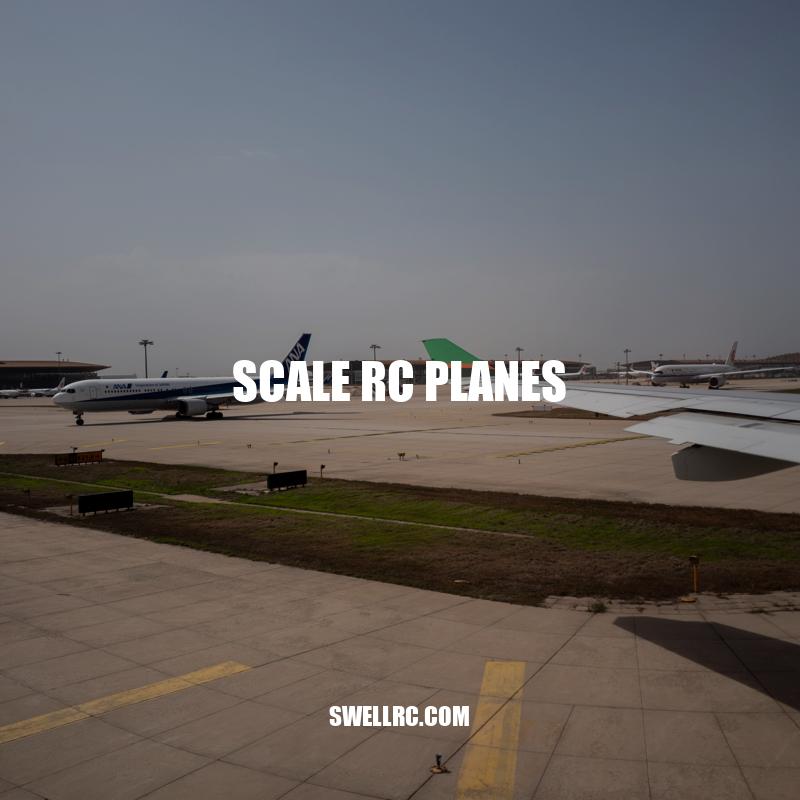Exploring Scale RC Planes: Types, Features, and Future Trends
Scale RC planes are a particular type of remote-control aircraft that replicates a full-size plane in exact measurement and detail. These aircraft are constructed to recreate the real thing in every aspect, including design, color schemes, and surface details. Scale modeling has been a popular hobby for many years, and the internet has made it possible for enthusiasts worldwide to share their experiences and knowledge. Scale RC planes are a perfect example of model making’s fascinating world, as it offers endless possibilities of customization and creativity with a mix of challenging and rewarding experience. Understanding the various types of scale planes, details and features, building techniques, flying challenges, and technology trends helps to develop this interesting hobby.
Types of Scale RC Planes
- Warbirds – represent planes that participated in military operations and battles, such as WWII P-51 Mustang, German ME-109, and Corsair F4U-1A.
- Civilian – are replicas of private planes that appeared in the history of aviation. It includes popular models like the iconic Piper J-3 Cub, Cessna 152, Beechcraft Bonanza and others.
- Sport – combine features of warbirds and civilian planes, where pilots can experience aerobatic maneuvers, scale flying, and exciting racing. These planes have unique characteristics like speed, agility, and stability, providing a thrilling and challenging experience for pilots.
Different types of scale RC planes are available for hobbyists to build, such as the following:
What are the characteristics of sport scale RC planes?
Sport scale RC planes typically have a scale appearance but are modified for improved flight characteristics, are designed to be easy to fly, and are built for aerobatics and sport flying. They are larger than typical RC planes and may have retractable landing gear and other intricate details.
Scale Details and Features
- Scale details are important to give a model plane an authentic look. Examples include:
- Panel lines, which are the gaps between sections in the fuselage and wings.
- Rivets, used to simulate the metal fasteners seen on real airplanes.
- Markings and decals, which represent the symbols, logos, and any text on the plane.
- RC planes also have features that are unique to scale models. Some of these include:
- Retractable landing gear, allowing the plane to take off or land without wheels protruding.
- Flaps, which increase lift, allowing the plane to take off at lower speeds and land more smoothly.
- LED lights, which can make for an impressive nighttime display.
Here is a table showing the sizes and scales of different RC aircraft:
| Size | Wingspan (inches) | Scale (size ratio) |
|---|---|---|
| Micro | less than 16″ | N/A |
| Mini | 16″-24″ | N/A |
| Park Flyer | 24″-48″ | N/A |
| Standard | 48-100″ | 1/16 – 1/5 |
| Large | 100-126″ | 1/5 – 1/4 |
| Giant | 126-144″ | 1/3 – 1/4 |
When it comes to scale RC planes, there are a few brands and models that stand out. One popular choice is the E-Flite P-51D Mustang, which is a 1/18 scale model with a wingspan of 39 inches. This plane has many scale details, such as molded panel lines and gun ports, and it comes with a variety of decals to customize its appearance.
Another popular option is the Hangar 9 Spitfire Mk IXc, a 1/5 scale model with a wingspan of 81 inches. This plane has many scale features, including a retractable landing gear and flaps that can be operated remotely.
For those interested in building their own RC planes from scratch, there are many kits and plans available online. One popular website for plans is RCGroups.com, which has a large community of builders sharing their designs and tips.
What are some popular brands and models of scale RC planes?
Popular brands and models of scale RC planes include the E-flite P-51 Mustang, the Hangar 9 Corsair, the Top Flite Giant P-51, and the FMS Super EZ Trainer.
Building or Buying Scale RC Planes
- Building a scale RC plane has its advantages and disadvantages:
- Pros to building include having complete control over the details and features and being able to customize the plane to your liking.
- Cons include the time and effort required to build and the possibility of mistakes or errors resulting in an imperfect end product.
- Many resources are available online for building your own RC plane, including forums, tutorials, and communities like the Academy of Model Aeronautics.
- Buying a scale RC plane is another option:
- Pros to buying include convenience and avoiding the hassle and time required to build the plane.
- Cons include the possibility of limited customization options, being unable to fully control the quality, and cost.
- Many online and brick-and-mortar hobby shops sell scale RC planes, offering various levels of detail and customization options. Websites like Horizon Hobby and Motion RC are popular online retailers with a wide selection of scale RC planes and accessories.
What are the pros and cons of building a scale RC plane compared to buying one?
Pros of building a scale RC plane:
1. Customization: Building your own plane allows for customization which can result in a unique plane that is tailored to your needs.
2. Learning Experience: Building a plane requires skills such as design, fabrication, and assembly which can provide a significant learning experience.
3. Cost: Building a plane can be cheaper than buying one, especially if recycling parts from old planes.
Cons of building a scale RC plane:
1. Time: Building a plane takes a lot of time, especially if you are a beginner.
2. Tools and Space: Building requires a lot of tools and space which may not be available or convenient for everyone.
3. Mistakes: If you are not experienced, building errors may occur that could damage a significant amount of time and money.
Pros of buying a scale RC plane:
1. Ready to use: Buying a plane saves time and effort since it is pre-built and ready to use.
2. Warranty: Most planes come with a warranty, which guarantees repairs or replacements in case of damage or malfunction.
3. Immediate Feedback: Purchasing a pre-built plane allows for quick feedback through test flights.
Cons of buying a scale RC plane:
1. Limited Customization: Buying a plane means you may have limited options on the design and accessories of the plane.
2. Cost: Pre-built planes can be expensive and some hobbyists may not want to invest in a ready-to-use plane.
3. Repair difficulty: Repairing pre-made planes can be complicated as some parts may be unique and replacements may not be available locally.
Flying Scale RC Planes
- Flying a scale RC plane comes with its own set of challenges:
- Because of their size and weight, scale RC planes can be more difficult to maneuver than smaller models.
- They also often require more advanced flying skills, such as knowledge of complex aerodynamics and attention to detail.
- Patience and practice are key to successful flights. Start with short, simple flights and work your way up to more advanced maneuvers as you gain confidence and experience.
- Here are some tips for successful flight and safe operation:
- Perform a preflight check of the plane and make sure all systems are functioning properly.
- Choose an appropriate flying location with plenty of open space and minimal obstacles.
- Avoid flying in windy or turbulent conditions as this can make controlling the plane more difficult.
- Always keep an eye on the plane and make sure it stays within your visual range. Consider using a spotter to help you keep track of the plane.
- Advanced techniques:
- Once you’ve mastered basic flying skills, you can move on to more advanced techniques such as scale aerobatics and formation flying.
- These techniques require a higher level of skill and experience, but can be very rewarding for those who take the time to master them.
- There are many resources available online for learning these advanced techniques, including video tutorials, forums, and experienced pilots who are often happy to share their knowledge.
What are some tips for safe operation when flying a scale RC plane?
Some tips for safe operation when flying a scale RC plane include reading the instruction manual thoroughly, conducting pre-flight checks, ensuring the aircraft is balanced and properly trimmed, checking the weather conditions, flying in an open area away from people and buildings, and avoiding flying near airports or restricted airspace.
Advancements and Future of Scale RC Planes
- Advancements in scale RC plane technology are constantly being made, including:
- Improvements in aerodynamics and materials to make planes more efficient and realistic
- Integration of advanced electronics, such as GPS and autopilot, for better control and safety features
- Use of 3D printing technology to create custom parts and even entire planes
- Development of first-person view (FPV) technology that allows pilots to see in real-time from the plane’s perspective.
- The future of the hobby is exciting, with many trends and developments emerging like:
- Increased use of drones for aerial photography and videography
- Growing interest in large-scale RC plane models, including 1/4, 1/3, and even 1/2 scale replicas of real planes.
- Interest in more unusual planes, such as flying wings and ornithopters.
- Advancements in virtual reality (VR) technology that could lead to a more immersive flying experience.
- Websites and online resources:
- For those interested in learning more about the hobby, there are many websites and online communities available:
- RCGroups.com is a popular forum where pilots can discuss all aspects of RC planes, including scale models.
- FliteTest.com is a website that offers resources and tutorials for building and flying RC planes, including several scale models.
- HobbyKing.com is an online retailer that offers a wide variety of RC planes, including many scale models.
What are some online resources for learning about scale RC planes?
Online resources for learning about scale RC planes include YouTube tutorials, online forums such as RCGroups.com and RCUniverse.com, instructional websites such as Flite Test and Academy of Model Aeronautics, as well as social media groups and pages dedicated to RC plane enthusiasts.
Conclusion
As we’ve seen, scale RC planes are a fascinating and rewarding hobby that can bring both joy and challenge to pilots of all skill levels. From the wide variety of types and features available to the advanced technology and new trends on the horizon, there is something for everyone in the world of scale RC planes. Whether you choose to build or buy your plane, it’s important to take the time to learn the necessary skills and safety precautions for successful flight.
With the help of online resources and community forums, pilots can connect with others who share their passion and learn from each other. As technology continues to advance, we can expect that the hobby will continue to evolve as well. With new materials, electronics, and even VR technology on the horizon, the future of scale RC planes looks bright.
Whether you’re a seasoned enthusiast or simply curious about the world of RC planes, there’s no better time to explore this fascinating hobby. So why not take the leap and experience the thrill of flying a scale RC plane for yourself? Who knows, it might just become your new favorite way to escape into the skies.



